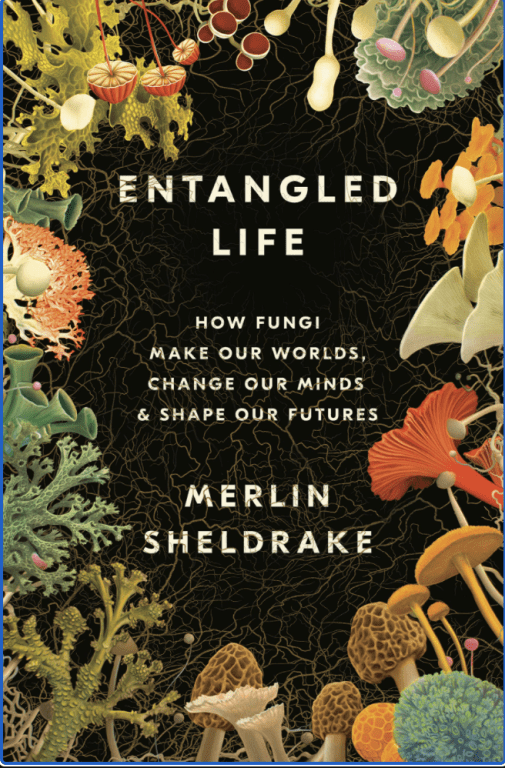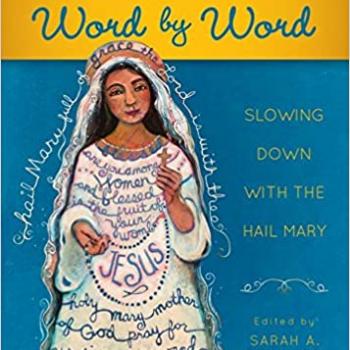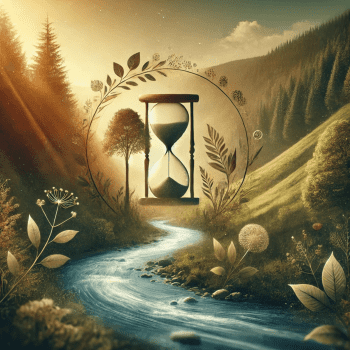Two years ago I wrote a post inspired by ecologist Peter Wolleben’s The Hidden Life of Trees. It’s one of those remarkable books that can significantly shift the way you experience the world. There is so much more happening with trees than is often apparent from our human point of view. In particular, there is growing scientific evidence that trees communicate with one another, share resources, and have intricate relationships with other trees in what is sometimes called the “wood wide web.”
If you don’t have time to read the book, The New York Times recently published a major article titled “The Social Life of Forests”. Note the subtitle: “Trees appear to communicate and cooperate through subterranean networks of fungi.” I want to pick up on that fungi piece: it turns out that fungi are fascinating and critical factors in facilitating the exchange of information and nutrients at the heart of nature’s social network, the “wood wide web.”
 And although I would still recommend The Hidden Life of Trees as the best and most accessible starting point for learning more (especially the new illustrated and condensed version), Wolleben, as a forester, understandably focuses on the tree side of the equation. And what inspired me to pick this topic back up again is a great new book titled Entangled Life; How Fungi Make Our Worlds, Change Our Minds, and Shape Our Futures from the mycologist (the fungi expert) Merlin Sheldrake, who focuses on the equally interesting fungus part in the social network of forests.
And although I would still recommend The Hidden Life of Trees as the best and most accessible starting point for learning more (especially the new illustrated and condensed version), Wolleben, as a forester, understandably focuses on the tree side of the equation. And what inspired me to pick this topic back up again is a great new book titled Entangled Life; How Fungi Make Our Worlds, Change Our Minds, and Shape Our Futures from the mycologist (the fungi expert) Merlin Sheldrake, who focuses on the equally interesting fungus part in the social network of forests.
He’s an interesting and quirky young scientist, and I suspect there is much more to come from him in the future. For instance, here’s a video of him turning form into function by eating the mushrooms growing out of his book about mushrooms (224). That’s some thoroughgoing commitment to your work!
Overall, the more I learn about so many different areas—especially biology and ecology, quantum entanglement in physics, and insights from my personal meditation practice—the clearer it becomes that the Seventh Principle in my chosen tradition of Unitarian Universalism (“Respect for the interdependent web of all existence of which we are a part”) is quite literal. We are so interdependent and connected with one another, with other living beings, and with the ecosystems of this planet on which we find ourselves.
Our growing awareness of the relationship between plants and fungi in the social life of forests is only the latest example of that classic line from John Muir from his book My First Summer in the Sierra: “When we try to pick out anything by itself we find it hitched to everything else in the universe” (110). I love that, and the deeper you live out of a felt sense of the interdependent web, the more that perspective shifts how you are in the world.
For now, the part that we are picking up—and finding it hitched to everything else—is fungus, and we are only at the tip of the iceberg of what there is to discover about the fantastical and fascinating world of fungi—which includes both mushrooms (the above-ground, fruiting body) and mycelium (the underground, branching, connecting, networking threads).
For instance, primatologist Jane Goodall told the mycology expert Paul Stamets the following in 2013 as she was learning more about the “wood wide web” and the potential breakthroughs in multiple areas from studying fungi: “Don’t stop. You’re with fungi where I was with the chimps when I started” (Stamets 42).
To say more about what that means, “The best estimates suggest that there are between 2.2 and 3.8 million species of fungi in the world—six to ten times the estimated number of plant species—meaning that a mere six percent of all fungal species have been described” (Sheldrake 10). In other words, more than ninety percent of fungi species remain undocumented. But we also know that, “More than ninety percent of plants depend on mycorrhizal fungi” in those underground shared networks of the “wood wide web” (4). So even as there are huge amounts still to learn about fungi, it is already the case that, “The more we learn about fungi, the less makes sense without them” (3).
Indeed, fungus turns out to be an incredibly frequent common denominator among plants, making fungus “a more fundamental part of plants than fruit, flowers, leaves, wood, or even roots” (124). Out of this symbiotic relationship, the fungus gets fed from the energy the plants produce through photosynthesis. In turn, the fungus can scavenge nutrients underground much more thoroughly than the roots of the plant ever could. And oftentimes the fungus connects and allows exchanges between plants through the fungus’s mycelial network (125).
The reality is so interdependent that it seems increasingly inaccurate to say that plants have roots, because that characterizes a plant’s situation as too isolated and independent. It’s much more accurate to say that plants have “fungus-roots”— hyphenated together as one linked word. That’s how interdependent and symbiotic the relationship is. Or you could say that fungi have “myco-rhizas,” —again hyphenating together into one linked word the branching mycelia of fungi and rhizomes growing out horizontally from plant roots (127).
From our human perspective, it is understandable that mushrooms are often the first thing we think of when we think of fungus. They are large, above ground, and fascinating (5). And I love that the Native American language Potawotami includes the word puhpowee, which means “the force which causes mushrooms to push up from the earth overnight” (213).
All right, we’re starting to get toward the end, and there’s so much more to say about the entangled lives of fungi—and how many significant innovations (for our human health care, disease treatment, and many other areas) will likely come from the intensive study of fungi, mushrooms, and mycelium in the years to come. If you are interested in learning more, another good overview is the book Fantastic Fungi by Paul Stamets, which is the summary of a documentary by the same name and creator available for rent on various streaming platforms.
Incidentally, any of my fellow Star Trek nerds out there will recognize that the TV show Star Trek: Discovery took all this fungi research to the next level with tons of mycelium-related themes and technology, including naming a main character and “astromycologist” Paul Stamets in honor of the cutting edge research the real life Paul Stamets is doing in our own present day (197-8).
For now, let me share with you just one more significant aspect. Although fungi do not have brains in the way that we humans typically think of them, numerous peer-reviewed experiments have demonstrated that the mycelium of most species of fungi “actively sense and respond to their surroundings….” The hyphae (the long, branching filamentous parts) have a lot going on. They allow the fungus to “interpret the chemical emissions of others to negotiate a series of complex trading relationships with trees; to knead away at stores of nutrients in the soil; to have sex; to hunt; or to fend off attackers” (41). Moreover, in tests using mazes and blocks of wood, “Mycelium appear to possess a directional memory, although the basis of this memory remains unclear” (47).
The fascinating upshot is that, on the spectrum of sentience or cognition, “intelligent behaviors can arise without brains. A dynamic and responsive network is all that’s needed” (66). As with the hidden life of trees, there’s a lot more going on—a lot of it quite complex—with the entangled life of fungi than seems initially to be the case from our limited human perspectives.
Along these lines, I find it fascinating that one of the things mushrooms have become famous for doing is helping us break down barriers to our understandings of the connections in our own amazing human brains. For instance, here’s a graphic of the “interconnections between networks of [human] brain activity during normal waking consciousness.” Beside it is the brain on Psilocybin—so-called “magic mushrooms.” Note the the tumult of new neuronal pathways that arise. There’s a lot more to say about all that, and if you are curious to learn more, I recommend Michael Pollan’s excellent book, How to Change Your Mind.
As I move toward my conclusion, I’ll say that I think Dr. Sheldrake, the master mycologist, is onto something when he says that, “My exploration of the fungal world has made me reexamine much of what I knew. Evolution, ecosystems, individuality, intelligence, life—none are quite what I thought they were. My hope is that this book loosens some of your certainties, as fungi have loosened mine” (23).
Keeping in mind that hope of loosening our preconceptions, I invite you to read an interesting poem titled “View with a Grain of Sand” by the Polish poet and winner of the Nobel Prize in Literature, Wisława Szymborska. As you read, consider the alternative, non-human views of the world that the hidden lives of trees and the entangled lives of fungus invite us to consider.
Our limited human point of view is not the only way of perceiving the world. So much can begin to open as we consider other angles of perspective inherent in the interdependent web of all existence of which we are inextricably a part.
In that spirit, I want to invite you into a little experiment. Right now in this present moment–in real time– open your heart, mind, and spirit to the interdependent web. Pause and in the silence, open yourself to what is sometimes called “Big Mind – Big Heart.” Don’t overthink what that means. See if you can just do it: open into Big Mind and Big Heart. Take it for a test drive. See what happens. What do you notice?
As Big Mind and Big Heart, there is…
openness,
expansiveness,
warmth,
connection with all living beings.
There is so much room.
May we learn to live out of of a felt sense of the interdependence web of all existence of which we are all a part.
The Rev. Dr. Carl Gregg is a certified spiritual director, a D.Min. graduate of San Francisco Theological Seminary, and the minister of the Unitarian Universalist Congregation of Frederick, Maryland. Follow him on Facebook (facebook.com/carlgregg) and Twitter (@carlgregg).
Learn more about Unitarian Universalism: http://www.uua.org/beliefs/principles
















